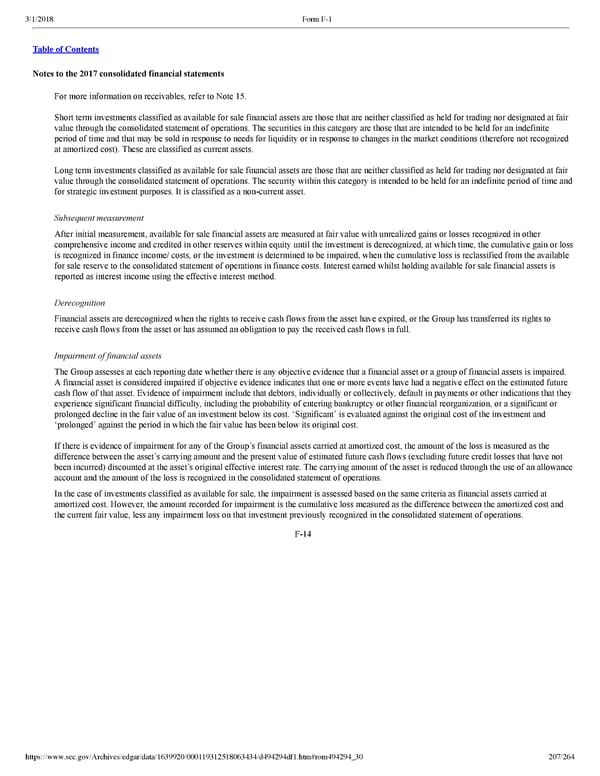207/264 Notes to the 2017 consolidated financial statements For more information on receivables, refer to Note 15. Short term investments classified as available for sale financial assets are those that are neither classified as held for trading nor designated at fair value through the consolidated statement of operations. The securities in this category are those that are intended to be held for an indefinite period of time and that may be sold in response to needs for liquidity or in response to changes in the market conditions (therefore not recognized at amortized cost). These are classified as current assets. Long term investments classified as available for sale financial assets are those that are neither classified as held for trading nor designated at fair value through the consolidated statement of operations. The security within this category is intended to be held for an indefinite period of time and for strategic investment purposes. It is classified as a noncurrent asset. Subsequent measurement After initial measurement, available for sale financial assets are measured at fair value with unrealized gains or losses recognized in other comprehensive income and credited in other reserves within equity until the investment is derecognized, at which time, the cumulative gain or loss is recognized in finance income/ costs, or the investment is determined to be impaired, when the cumulative loss is reclassified from the available for sale reserve to the consolidated statement of operations in finance costs. Interest earned whilst holding available for sale financial assets is reported as interest income using the effective interest method. Derecognition Financial assets are derecognized when the rights to receive cash flows from the asset have expired, or the Group has transferred its rights to receive cash flows from the asset or has assumed an obligation to pay the received cash flows in full. Impairment of financial assets The Group assesses at each reporting date whether there is any objective evidence that a financial asset or a group of financial assets is impaired. A financial asset is considered impaired if objective evidence indicates that one or more events have had a negative effect on the estimated future cash flow of that asset. Evidence of impairment include that debtors, individually or collectively, default in payments or other indications that they experience significant financial difficulty, including the probability of entering bankruptcy or other financial reorganization, or a significant or prolonged decline in the fair value of an investment below its cost. ‘Significant’ is evaluated against the original cost of the investment and ‘prolonged’ against the period in which the fair value has been below its original cost. If there is evidence of impairment for any of the Group’s financial assets carried at amortized cost, the amount of the loss is measured as the difference between the asset’s carrying amount and the present value of estimated future cash flows (excluding future credit losses that have not been incurred) discounted at the asset’s original effective interest rate. The carrying amount of the asset is reduced through the use of an allowance account and the amount of the loss is recognized in the consolidated statement of operations. In the case of investments classified as available for sale, the impairment is assessed based on the same criteria as financial assets carried at amortized cost. However, the amount recorded for impairment is the cumulative loss measured as the difference between the amortized cost and the current fair value, less any impairment loss on that investment previously recognized in the consolidated statement of operations. F14
 Spotify F1 | Interactive Prospectus Page 206 Page 208
Spotify F1 | Interactive Prospectus Page 206 Page 208